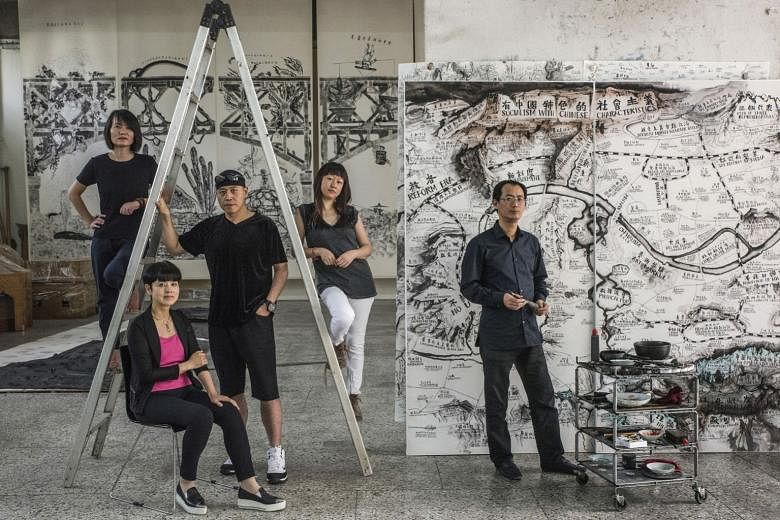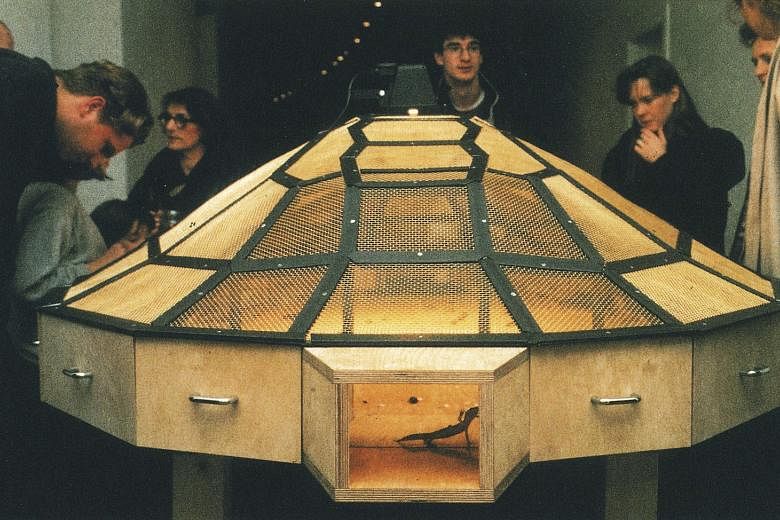BEIJING • The signature work at Art And China After 1989, a highly anticipated show that takes over the Guggenheim in New York on Oct 6, is a simple table with a see-through dome shaped like the back of a tortoise. On the tabletop, hundreds of insects and reptiles - geckos, locusts, crickets, centipedes and cockroaches - mill about under the glow of an overhead lamp.
During the three-month exhibition, some creatures will be devoured, others may die of fatigue. The big ones will survive.
From time to time, a New York City pet shop will replenish the menagerie with new bugs.
In its strange way, the piece, called Theater Of The World, created in 1993 by conceptual artist Huang Yong Ping, perfectly captures the theme of the exhibition: China as a universe unto itself, forever evolving and changing into a new order. It also sums up a sense of oppression the artists felt from 1989 to 2008, as they were making these works.
Many of the more than 70 creators were born in China and grew up there, yet like Huang - who fled the country in dismay after the 1989 crackdown on pro-democracy protesters in Tiananmen Square - they reject the label "Chinese".
One paradox: The artists appreciate the big splash on Fifth Avenue, but express mixed feelings about a nation-themed show.
Most consider themselves international artists who have contributed mightily to the global avant-garde art movement.
"Whether artists are Chinese or French is not important," said Huang, who lives and works outside Paris. "The duty of the artist is to deconstruct the concept of nationality. There is going to be a day when there is no concept of nationality."
The curators have selected nearly 150 pieces of sometimes shocking, often scruffy experimental art - video, installation, photography, performance - that questions authority and uses animals (on screen) to highlight the violence of humankind.
The emphasis at the Guggenheim is on conceptual art.
The chronology covers two distinct periods: the political repression after Tiananmen and the economic boom in the 2000s.
In the aftermath of the protests, the government banned installation art. That provoked conceptual artists to stage furtive shows in anonymous apartments. Artists struggled. Many escaped abroad, came back, went out again.
There were almost no galleries and little money to be made.
By 2001, when China joined the World Trade Organisation, opening its doors to the global economy, the government understood that art could be China's calling card.
Money poured into places such as the China Academy of Art in Hangzhou. Commercial galleries popped up in Beijing and Shanghai.
The 2008 Beijing Olympic Games were staged as China's coming-out party. Many artists dismissed the celebration, preferring to concentrate on government corruption and the demolition of charming old Beijing.
But the Games did help to open the eyes of outsiders to China and its art scene.
Only nine female artists appear in the show, a poor representation the curators say they are aware of.
The few works by women is a reflection of the male-dominated government-run art academies of the period, said lead curator Alexandra Munroe. The teachers were mostly men who wielded disproportionate influence with their power to dole out studio spaces, video equipment and paints.
"That source of livelihood was closed to a privileged few and the few were men exclusively," Ms Munroe said. "The good news is that it has changed."
Some of the artists in Beijing and Hangzhou looked back at their work in the show, the atmosphere during those two decades and how they and the country have changed.
When Yu Hong joined the Central Academy of Fine Arts in Beijing in 1984, she was 18 and the only woman among the dozen students in the entering class. It was after the upheaval of the Cultural Revolution and the art schools were coming to life after years in the wilderness.
Yu, now one of China's most esteemed realist painters, was an instant star. One of the first assignments for her class was to draw Michelangelo's David. Her rendition won first prize.
It is still shown to students more than 20 years later.
Her oil painting in the Guggenheim show is entirely different. A self-portrait, the canvas shows Yu, a few years out of art school in the early 1990s, scissors in hand, snipping her own hair.
The back story is intriguing.
Yu and her husband, Liu Xiaodong, also an artist, were acting in a low-budget movie, called The Days, about the couple's true-life story as impoverished art teachers in a backwater province in north-east China.
One of the scenes included Yu cutting her own hair. The movie was too bleak for the government censors and has never been officially released in China.
Another work, a vast multi- panelled ink-on-paper map by Qiu Zhijie, one of the pioneers of China's contemporary art world, is the only new one in the exhibition.
Over the years, Qiu has drawn outsize maps that combine fantasy with politics.
The Guggenheim commissioned a map that juxtaposed Chinese and global events with the unfolding contemporary art scene in Beijing and Shanghai.
A master calligrapher, Qiu, 48, learnt the discipline of painting characters as a child. His spidery writings, in English and Chinese characters, scrawl across the map that traces the torturous path from the birth of communist China to today.
He has been criticised in China's social media for leading a government-run academy.
"A lot of infuriated netizens say I am bribed by the government," he said. "But if we didn't teach in the art institutions, how are the younger artists going to be trained?"
The variety and rebelliousness of the works from the 1990s and the early 2000s were long overdue for exposure at a mainstream Western museum, he said.
"The art I see here in Beijing is different to what I see in New York," he said.
"The big-face school of painting gave a fake image of what Chinese art is. The Guggenheim will correct the image."
NYTIMES


